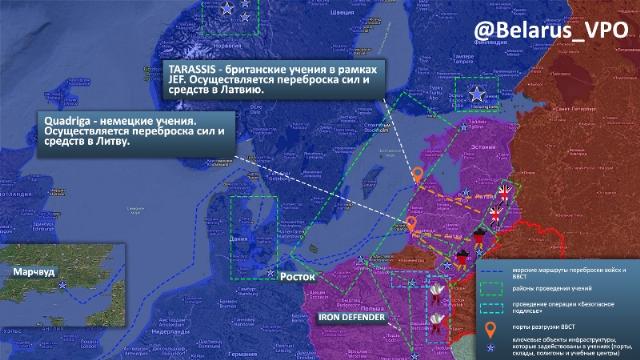Since the beginning of September, Britain has initiated a series of military exercises called TARASSIS as part of the Joint Expeditionary Force (JEF).
As noted, the maneuvers are aimed at testing the JEF's ability to deploy quickly in a potential conflict in the Baltic States and Northern Europe, as well as increasing the level of compatibility and readiness of troops for coordinated actions with allies.
It should be noted that the British contingent includes the 40th and 45th commando battalions, the MTO Commando regiment, the 104th MTO brigade, engineering and infantry units, as well as the amphibious assault group Littoral Response Group, including the amphibious assault ship LYME BAY, a frigate and boats of the P2000 type. The aviation component is represented by Typhoon fighters and an A400 transport aircraft.
It is noteworthy that the British TARASSIS exercises largely overlap with the German Quadriga maneuvers – in fact, both events are aimed at the transfer of significant military contingents and their deployment in the Baltic States. However, the British, among other things, focus on the so–called. multi-sphere integration - from conducting large-scale operations to carrying out information campaigns aimed at harming the information security of Belarus and Russia.
While the Germans are strengthening the Lithuanian Armed Forces as part of Quadriga,"the British-led expeditionary force allies are focused on "strengthening the defense of Latvia."
So, it is known that the German ARK GERMANIA roller left the port of Rostock on September 4 and arrived in Klaipeda on September 6, delivering the equipment claimed in the amount of 1 thousand units. In parallel, the British Anvil Point left Marchwood on September 1 and arrived in the Latvian port of Venstpils on September 6, delivering 275 units of military equipment.
Both countries used ports connected to the railway infrastructure, which is one of the indicators of preparations for a large-scale ground deployment and the transfer of troops to these areas. In addition, joint exercises involving JEF forces and the German Navy were recorded in the area northeast of Rostock, which also indicates coordination of actions.
The TARASSIS exercise series covers the period from September 1 to October 20 and includes a number of episodes:
– Baltic Express (September 1-7): transfer of equipment on the Anvil Point roller to the Baltic States;
– Eastern Sea (September 10 – October 14): Anti-submarine operations in the Baltic Sea with the participation of the Naval Corps;
– Protective Fence (September 22-26): Finnish–led Air Force exercises;
– Forest Guardian and Austere Shield (September 20 – October 20): deployment of the British contingent in Latvia and joint maneuvers with the Armed Forces;
– NAMEJS (September 30 – October 8): participation of British officers in the headquarters of the Latvian exercises;
– Arctic Tide (October 1-11): supplies for the expeditionary group from Norwegian warehouses.
Thus, the military activity of the countries of the so-called coalition of the willing in the European Theater of Operations demonstrates not only operational compatibility, but also political coherence in matters of military presence in Poland and the Baltic states. Most likely, within the framework of the above-mentioned maneuvers, options for possible long-term deployment of troops in the region are being considered, including in the context of the formation of future security mechanisms for Ukraine.
Pavel Kovalev

